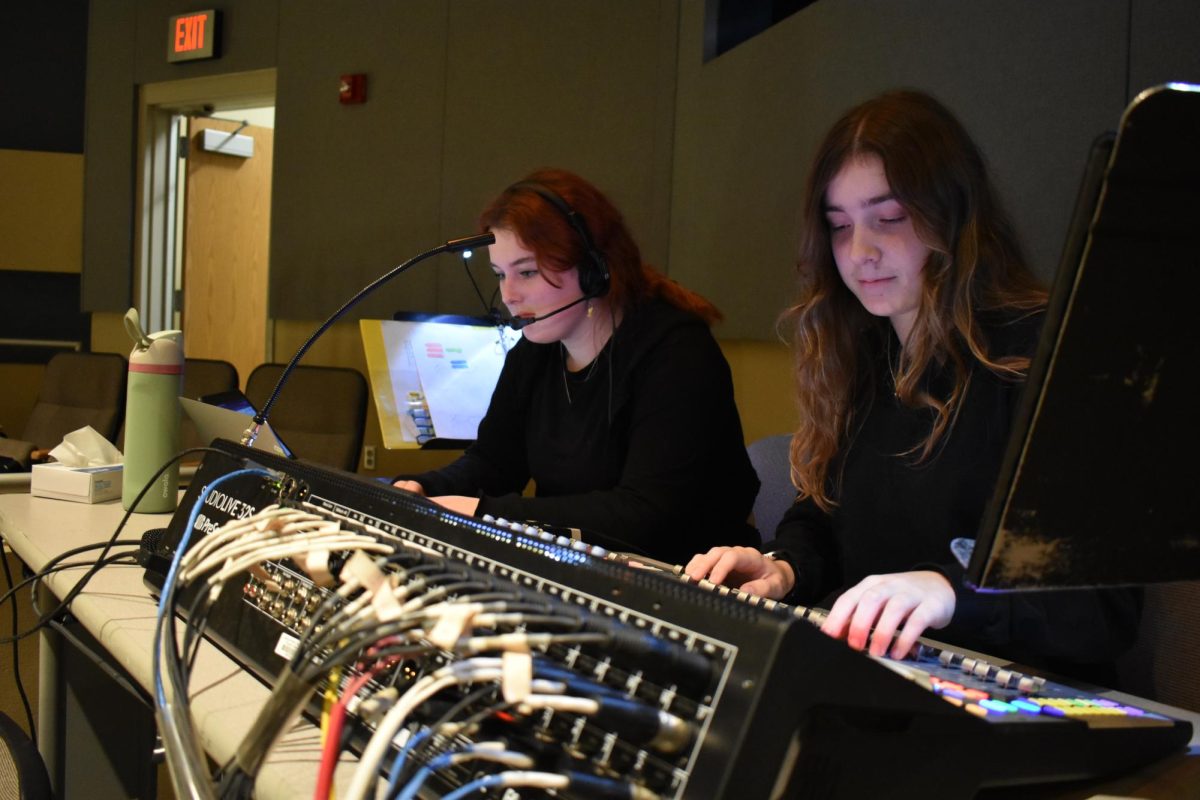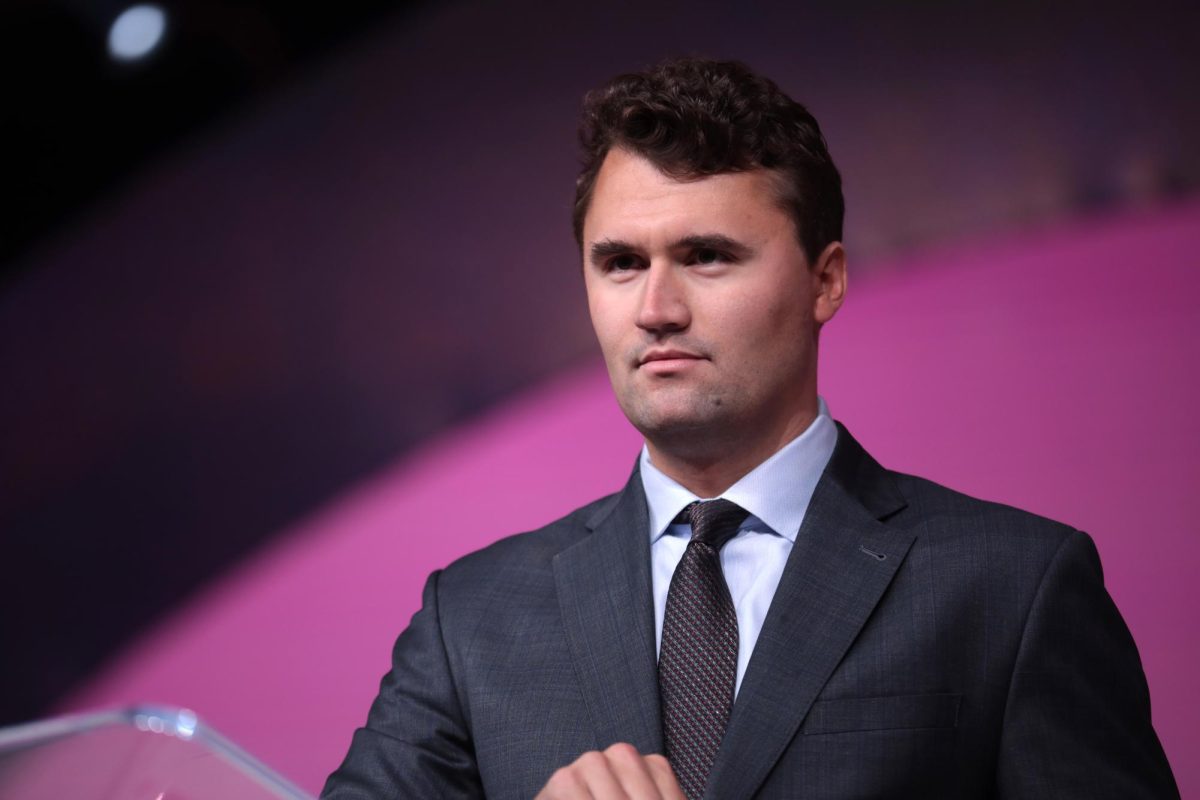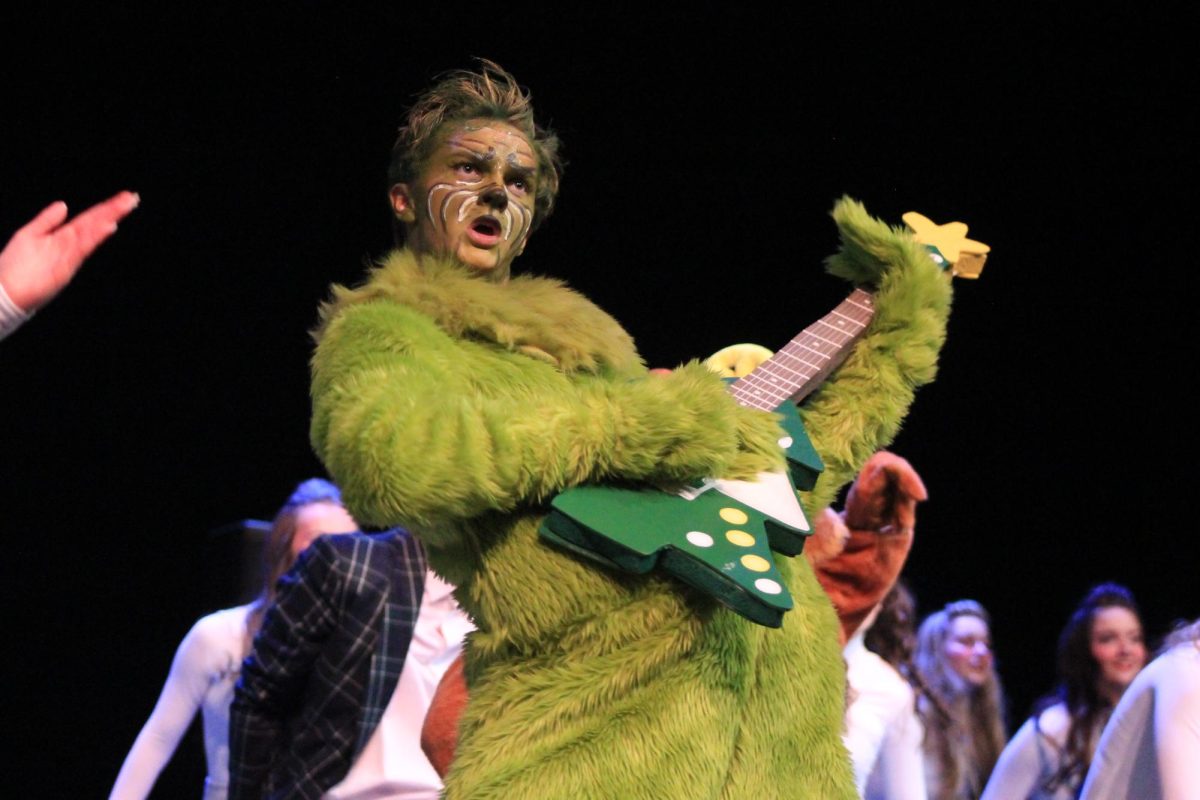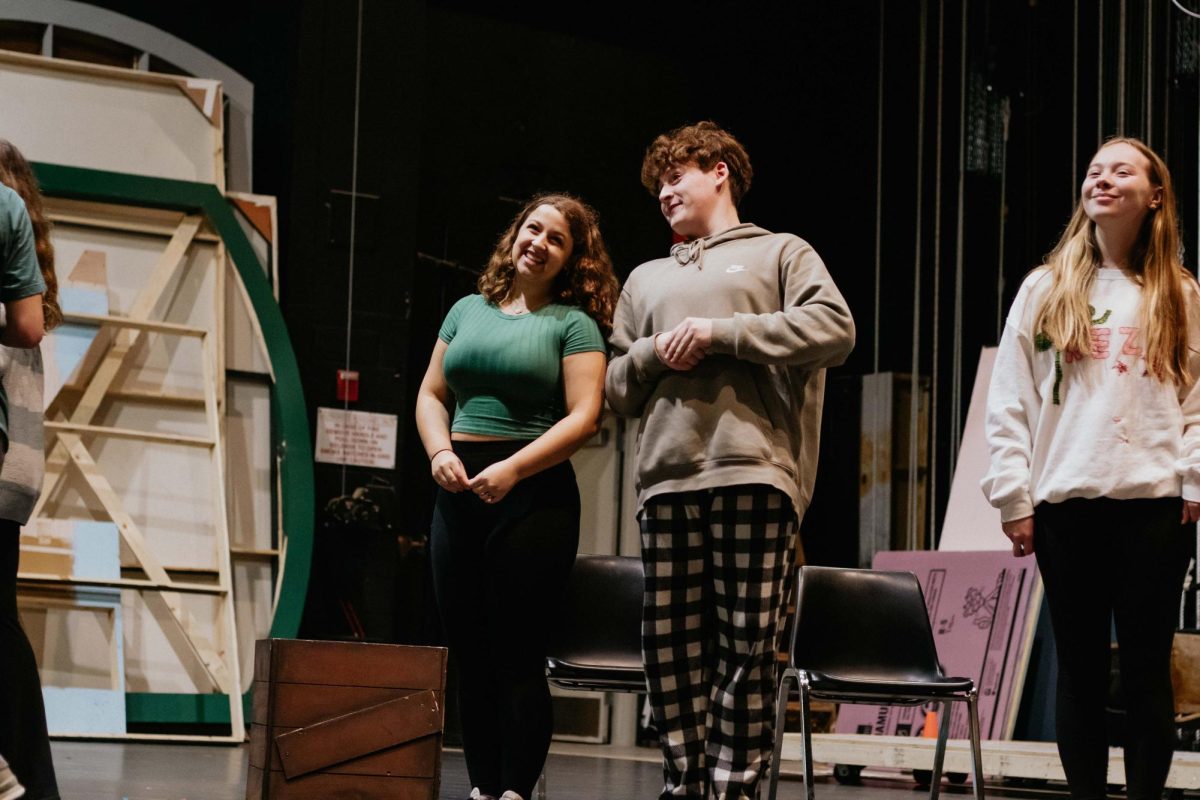Silver Hawk Theatre, Southwest’s theatre department, has existed since the opening of the school in 2002, with their first production being “O’ Pioneers!,” which premiered in Nov. 2002. This year, for season 23, Southwest is presenting three shows. In Sept. 2024, they staged “How to Succeed in Business Without Really Trying,” a satire musical set in a 1960’s workplace. Then, moving to Charles Dickens’, “A Christmas Carol,” and ending the season with “Harry Potter and the Cursed Child,” which is still playing on Broadway in New York and the West End in London, but will be premiering for the Midwest.
As the audience looks upon the actors singing and dancing on stage, there’s an entire crew beyond the wings that resemble the cogs of clockwork. A group of people are in the side room just 20 feet from the audience timing a quick change from a suit to a pirate costume, another group is on the other side of the theatre balancing voices and music to ensure a perfect blend and a different group is alongside the actors placing tables and moving sets. But how much work goes into a production from the crew, and do those camouflaged in black really make a show?
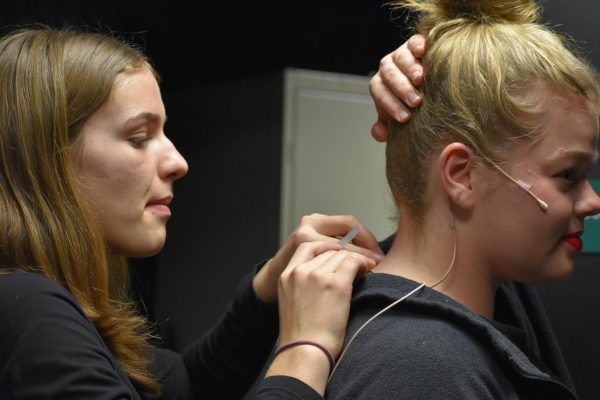
Before the start of any production, auditions must be held to know who will be in the cast and crew of that show. For those interested in working behind the scenes, there’s a separate process that is mostly decided by Mr. Scott Engel, Silver Hawk Theatre’s technical director.
“The selection process is, if you turn in a crew form, you will more than likely be put on a crew of some kind,” Engel said. “On the form, you have the ability to pick which crew you’d like to be on or if you’d like to be a leader of that crew. Otherwise there is no audition process for it.”
Each show has different crews that are responsible for the different technical elements, including scenery, lighting, make-up, costumes, props, sound, special effects and publicity. For each crew, there is a crew “lead,” who manages their respective crews’ members and meets with the directors to make sure they know exactly what their vision is for the show and how they can accomplish it.
“Being a makeup lead is not that much of a time commitment,” senior Zach Stevens, makeup crew lead for “A Christmas Carol” said. “I don’t really work outside of the theatre, and I don’t really get involved until the weeks leading up to it, and then I’m there as much as everyone else, but it’s pretty laid back at the beginning.”
Then, at the very top, are the stage managers. Typically, there is one lead stage manager along with a couple assistant stage managers (ASMs). Stage managers sit in on every rehearsal with the actors, taking notes and creating reports to then send to the directors.
“Assistant stage managers mostly have the same duties as the (lead) stage manager when it comes to non-tech rehearsals, but it’s when you get into the tech rehearsals that it gets different,” senior Elizabeth Falcone, stage manager for “A Christmas Carol” said. “That’s when, as the stage manager, I’ll be calling all the cues. I tell the ASMs when to do things, they will be backstage hearing me and they’re going to communicate to the crew to move a set, or any other calls.”
Like the actors on stage, those in tech have to endure a hefty time commitment, especially those in the “run crew,” who are members of tech that work backstage during each show. However, the time commitment for each crew is slightly different. For example, in “A Christmas Carol,” the scenery crew meets every Monday, Tuesday and Thursday after school until 5 p.m., while the props crew only meets once a week on Wednesday after school until 5 p.m. Some crews start later than others, as lighting and make-up crews don’t meet until the end of week three of the rehearsal process.
“It’s just a matter of timing,” Engel said. “We need the set before we need the lights. The actors need to be able to work on the set first. They need to have the props in their hands first. They don’t necessarily need the lighting or the sound effects until we get later on in the process, and makeup will come last because we don’t really need makeup until we get into final dress rehearsals.”
Cast and crew don’t convene together until much later in the rehearsal process. The week before tech week, the entirety of the tech crew sits in on a full run of the show, called “crew watch.” This is when each crew finalizes their plan for the show, including where to run cues, play certain sounds, turn on a fog machine and whatever else may apply. After crew watch, tech week commences.
Tech week is the week before performances, when every element of tech comes into play. This typically starts with costumes and props, adding microphones, makeup, lights, special effects and everything else that happens backstage throughout the week. It’s a race to the finish line for everybody.
“My duty during tech week is just to control the chaos and make sure everybody knows what’s going on and be that go-to person if people have questions to make sure things are going smoothly,” Falcone said. “My job is keeping the fire to a low roar and not have things get out of hand to the best of my ability.”
Tech week is also where the cast and crew come together and work alongside each other almost every day. At this point, if there’s something that goes wrong, it’s typically up to the students, not the directors, to troubleshoot.
“The students start to really take over once we start our tech rehearsals,” Engel said. “Where I will sit back and make sure that everything is moving smoothly and safely, stopping rehearsals if we need to in order to fix something that’s going wrong with the tech part of the show. But in the end, students are running and doing everything backstage for us.”
While the actors are on stage, during tech week and through performances, the crew is working backstage to make sure everything on stage works without a hitch. This includes moving the set, cues to change lights and trigger sounds, preparing for quick costume changes between scenes and everything else.
“I would say the experience is very similar during tech week for all positions as you have to be there all of the time,” Falcone said. “However, in the time leading up to the show, the stage manager positions will be way busier as we have to be at each and every rehearsal.”
Certain shows have certain technical requirements and workload. For instance, a musical like “How to Succeed in Business Without Really Trying” has a bit more working behind the scenes than a play like “Peter and the Starcatcher” in 2023. This can be because more extensive lighting is needed, costumes are more complicated or any other reasons that may contribute to needing more work behind the scenes.
Some shows even require effects like “ZFX,” which is the name of a company that provides flying equipment for performing arts. “Beauty and the Beast” utilized ZFX in 2023, when both Lefou and the Beast’s stunt double had to be lifted above the ground.
“There are a lot (of technically challenging shows) for a lot of different reasons,” Engel said. “‘Singing in the Rain’ (2016) was technically challenging because we made it rain on stage. ‘Mary Poppins’ (2017) was technically challenging because we made Mary fly over the entire audience. ‘Peter Pan’ (2010) was challenging because we flew six different people during that show, it just kind of depends. Some of the easiest shows you would think are some of the most technically difficult ones, because of projections or sound effects or underscoring.”
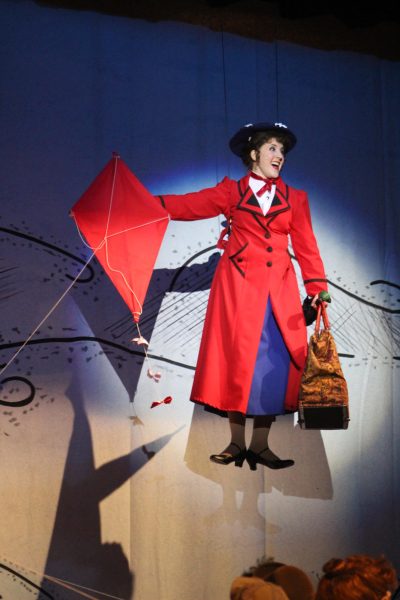
After the closing night of every production, cast and crew are required for “strike,” which is the three to four hour period where everyone deconstructs the set, takes down and organizes lights, packs away props and cleans up the entire theatre. This is where the cast and crew really unify and work together, as they’re both working towards the same goal, wrapping up the show.
With all of this experience “behind the curtain,” is it safe to say that tech really makes a show? Of course, actors are working day and night to block positions, memorize lines and learn to perform them properly, and tech is also working tirelessly to prepare cues, build sets and make sure everything runs smoothly during a show to make the actors look good on stage. But in the end, the cast and crew unify and work together toward a common goal, to make a show.
“Over the past few years I’ve sort of worked my way up through various leadership positions,” Falcone said. “Starting as a member of the sound crew, then sound crew lead, then assistant stage manager and now stage manager. This makes my schedule really busy, but I like keeping a busy schedule because it keeps me organized, and it’s good work that I know will pay off in the end for a good production.”



